A Novel Shadowgraphic Inline Measurement Technique for Image-Based Crystal Size Distribution Analysis
Abstract
1. Introduction
1.1. Particulate Measurement Techniques
1.2. Shadowgraphic Optical Probe and Online Microscope
2. Materials and Methods
2.1. Experimental Setup
2.2. Substances
2.3. Experimental Procedure
2.4. Image Processing
3. Results and Discussion
3.1. Comparison of the Crystal Size Measurement Techniques with KH2PO4 Crystals
3.2. Investigation of KH2PO4 at Elevated Temperature
3.3. Crystallization of Thiamin Hydrochloride Monohydrate
4. Conclusions
Author Contributions
Funding
Acknowledgments
Conflicts of Interest
Appendix A
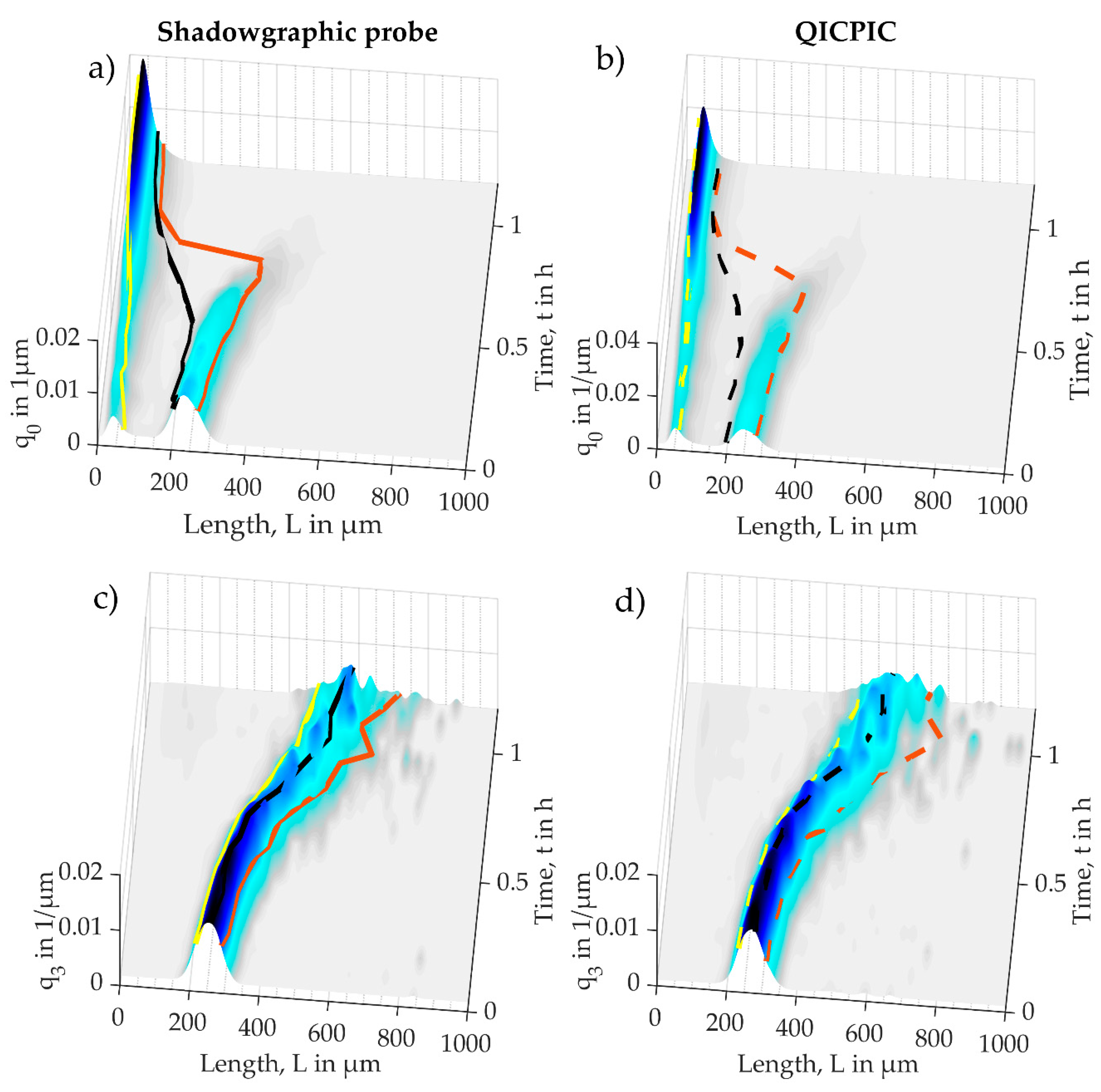
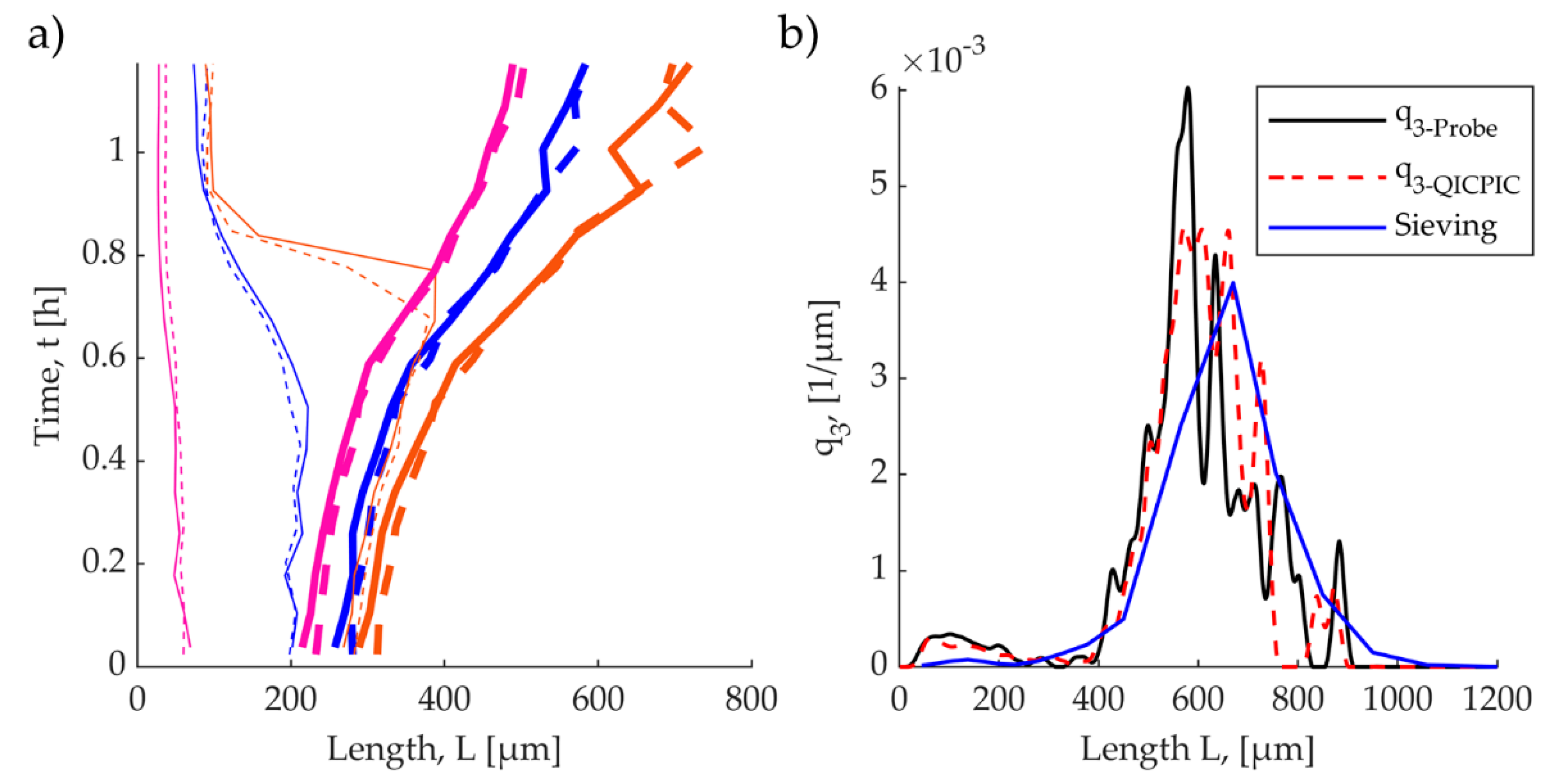
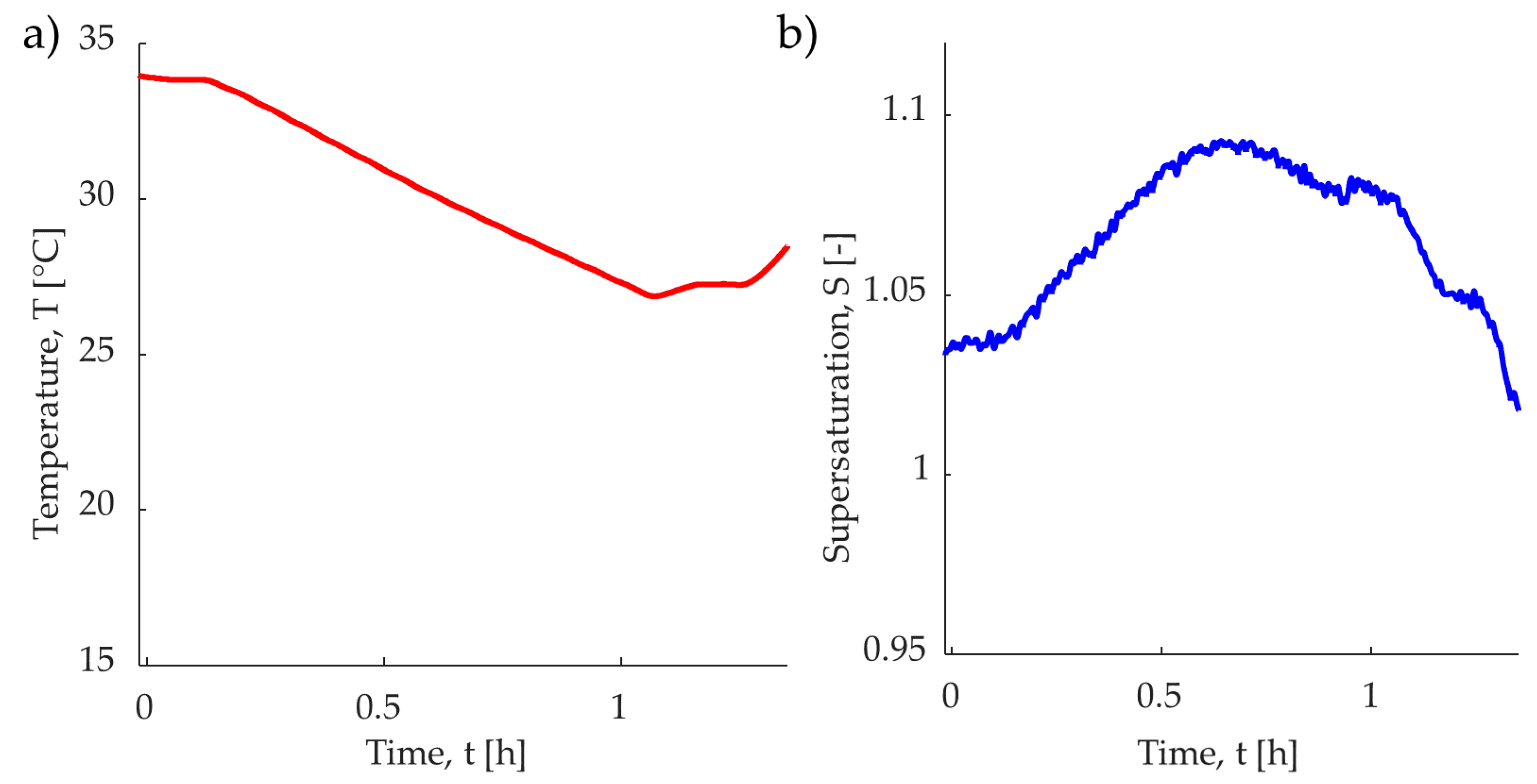
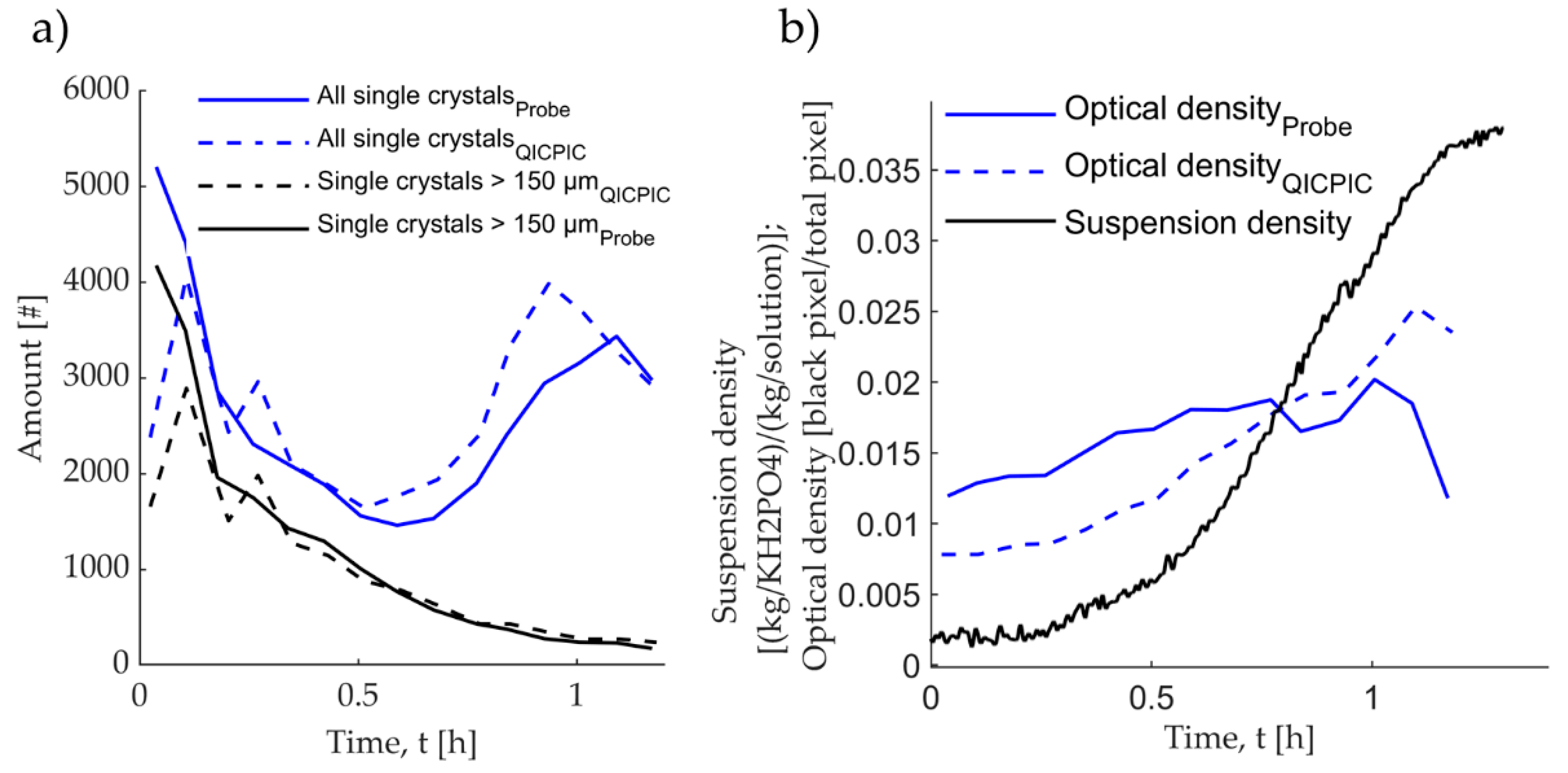
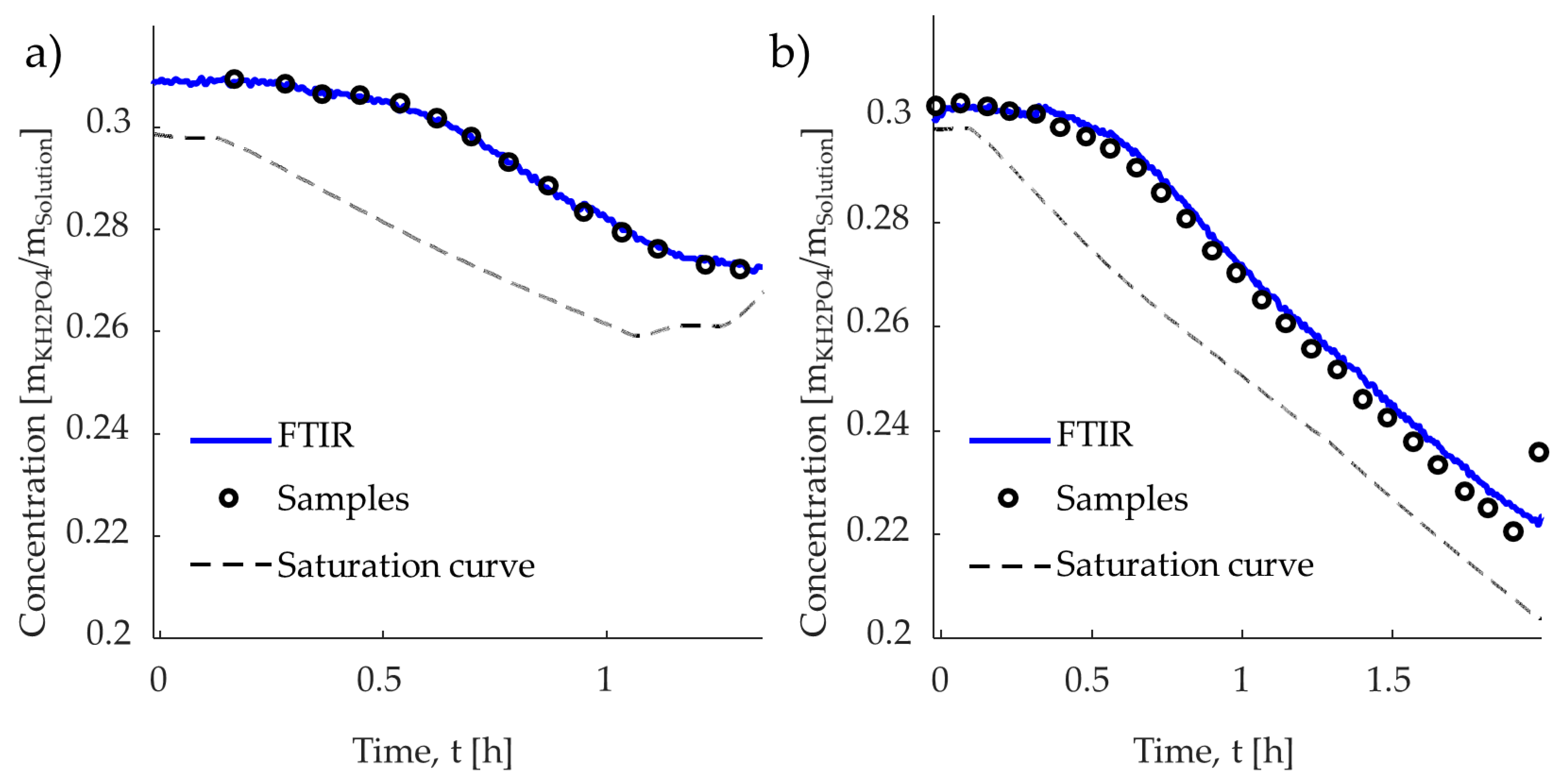
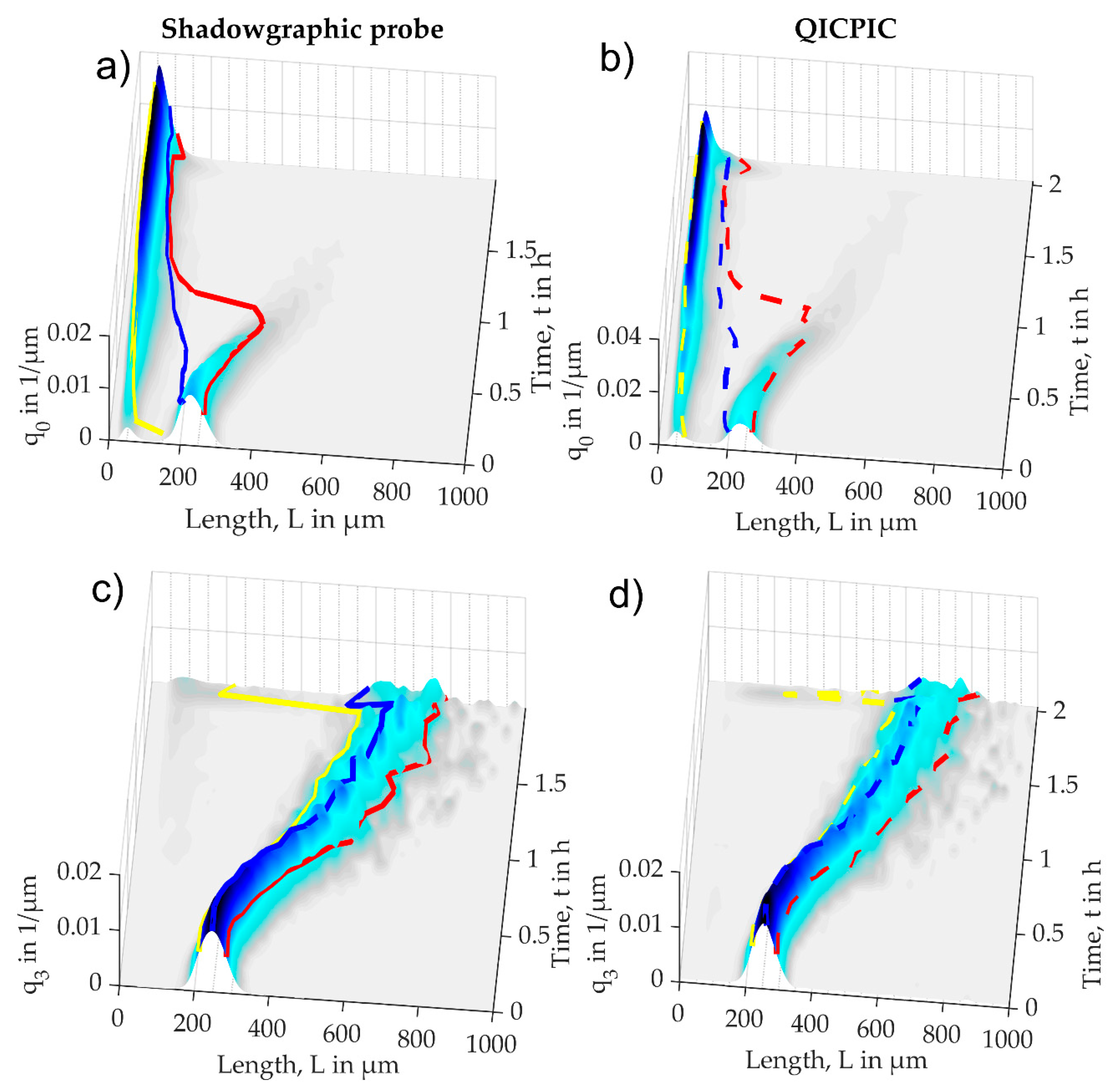
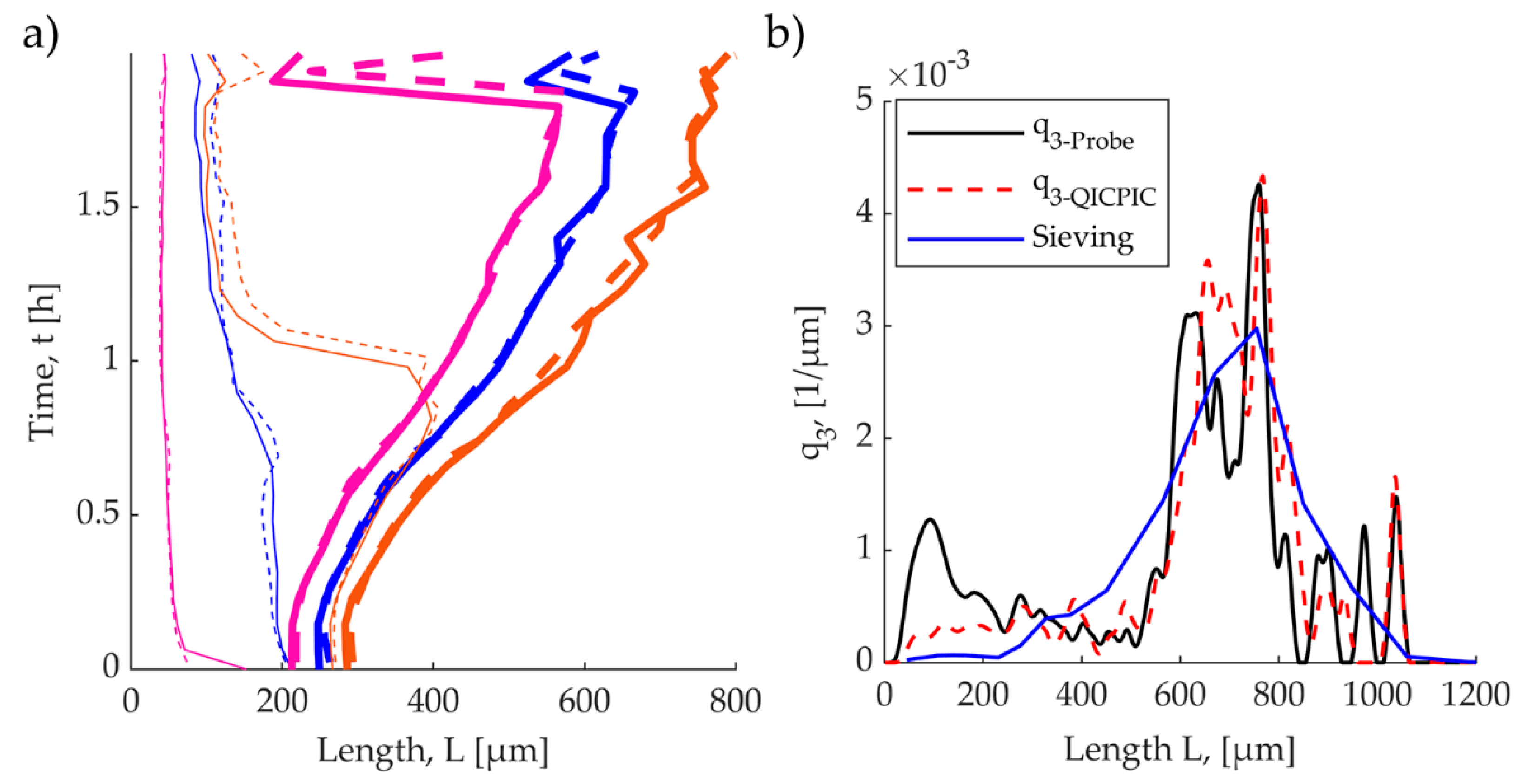

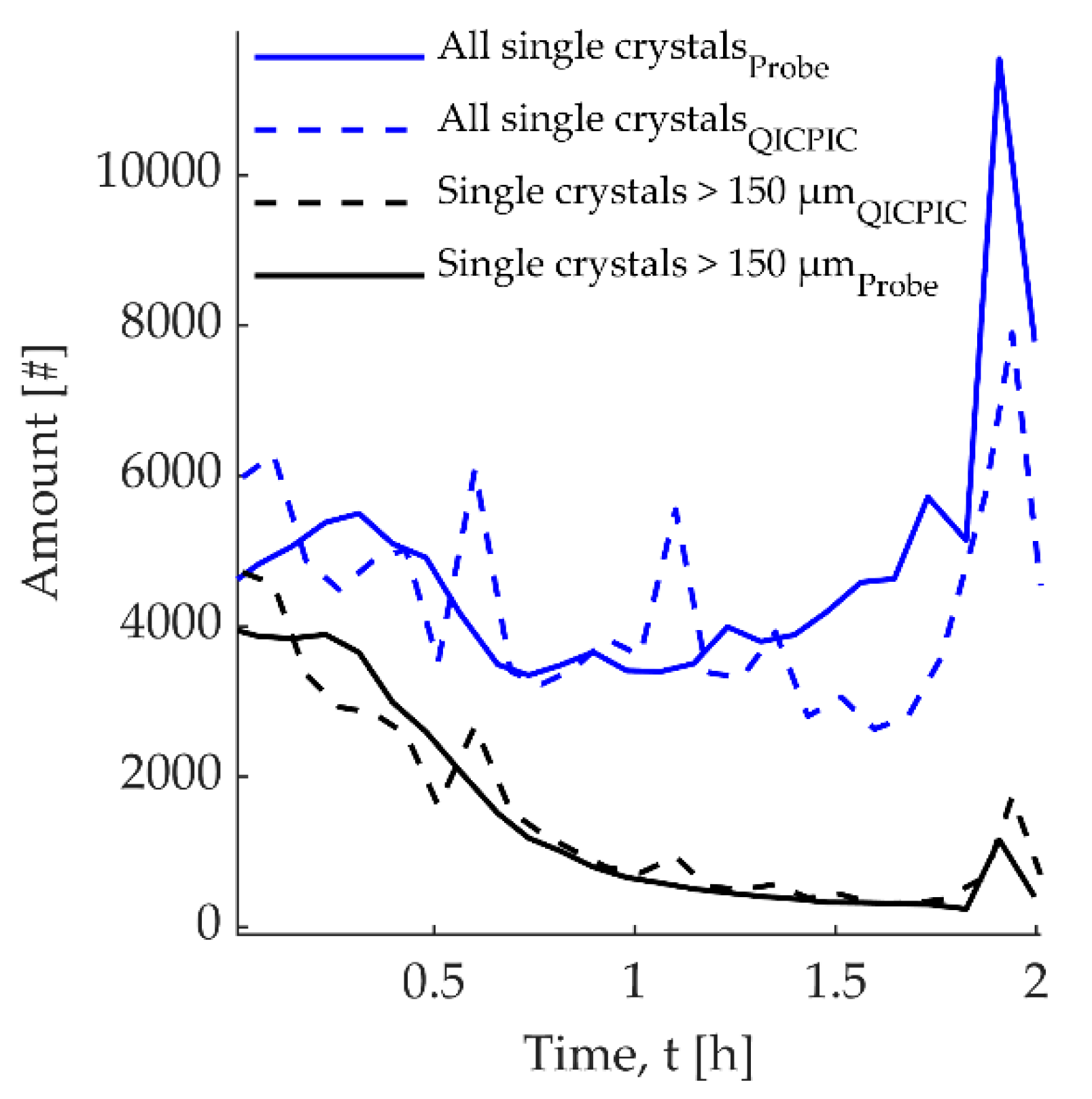
References
- Chow, K.; Tong, H.H.Y.; Lum, S.; Chow, A.H.L. Engineering of Pharmaceutical materials: An industrial perspective. J. Pharm. Sci. 2008, 97, 2855–2877. [Google Scholar] [CrossRef] [PubMed]
- Wibowo, C.; Chang, W.-C.; Ng, K.M. Design of integrated crystallization systems. AIChE J. 2001, 47, 2474–2492. [Google Scholar] [CrossRef]
- Braatz, R.D. Advanced control of crystallization processes. Annu. Rev. Control 2002, 26, 87–99. [Google Scholar] [CrossRef]
- Ulrich, J.; Frohberg, P. Problems, potentials and future of industrial crystallization. Front. Chem. Sci. Eng. 2013, 7, 1–8. [Google Scholar] [CrossRef]
- Vetter, T.; Burcham, C.L.; Doherty, M.F. Regions of attainable particle sizes in continuous and batch crystallization processes. Chem. Eng. Sci. 2014, 106, 167–180. [Google Scholar] [CrossRef]
- Chen, J.; Sarma, B.; Evans, J.M.B.; Myerson, A.S. Pharmaceutical Crystallization. Cryst. Growth Des. 2011, 11, 887–895. [Google Scholar] [CrossRef]
- Tahir, F.; Krzemieniewska-Nandwani, K.; Mack, J.; Lovett, D.; Siddique, H.; Mabbott, F.; Raval, V.; Houson, I.; Florence, A. Advanced control of a continuous oscillatory flow crystalliser. Control Eng. Pract. 2017, 67, 64–75. [Google Scholar] [CrossRef]
- Su, Q.; Nagy, Z.K.; Rielly, C.D. Pharmaceutical crystallisation processes from batch to continuous operation using MSMPR stages: Modelling, design, and control. Chem. Eng. Process. 2015, 89, 41–53. [Google Scholar] [CrossRef]
- Lawton, S.; Steele, G.; Shering, P.; Zhao, L.; Laird, I.; Ni, X.-W. Continuous Crystallization of Pharmaceuticals Using a Continuous Oscillatory Baffled Crystallizer. Org. Process. Res. Dev. 2009, 13, 1357–1363. [Google Scholar] [CrossRef]
- Schlüter, M. Lokale Messverfahren für Mehrphasenströmungen. Chem. Ing. Tech. 2011, 83, 992–1004. [Google Scholar] [CrossRef]
- Lichti, M.; Bart, H.-J. Particle Measurement Techniques in Fluid Process Engineering. Chembioeng Rev. 2018, 5, 79–89. [Google Scholar] [CrossRef]
- Nagy, Z.K.; Fevotte, G.; Kramer, H.; Simon, L.L. Recent advances in the monitoring, modelling and control of crystallization systems. Chem. Eng. Res. Des. 2013, 91, 1903–1922. [Google Scholar] [CrossRef]
- Yu, L.X.; Lionberger, R.A.; Raw, A.S.; D’Costa, R.; Wu, H.; Hussain, A.S. Applications of process analytical technology to crystallization processes. Adv. Drug Deliv. Rev. 2004, 56, 349–369. [Google Scholar] [CrossRef] [PubMed]
- Ma, Z.; Merkus, H.G.; De Smet, J.G.A.E.; Heffels, C.; Scarlett, B. New developments in particle characterization by laser diffraction: Size and shape. Powder Technol. 2000, 111, 66–78. [Google Scholar] [CrossRef]
- Ma, Z.; Merkus, H.G.; Scarlett, B. Extending laser diffraction for particle shape characterization: Technical aspects and application. Powder Technol. 2001, 118, 180–187. [Google Scholar] [CrossRef]
- Cogoni, G.; De Souza, B.P.; Frawley, P.J. Particle Size Distribution and yield control in continuous Plug Flow Crystallizers with recycle. Chem. Eng. Sci. 2015, 138, 592–599. [Google Scholar] [CrossRef]
- Jia, C.-Y.; Yin, Q.-X.; Zhang, M.-J.; Wang, J.-K.; Shen, Z.-H. Polymorphic Transformation of Pravastatin Sodium Monitored Using Combined Online FBRM and PVM. Org. Process. Res. Dev. 2008, 12, 1223–1228. [Google Scholar] [CrossRef]
- Kail, N.; Marquardt, W.; Briesen, H. Process Analysis by Means of Focused Beam Reflectance Measurements. Ind. Eng. Chem. Res. 2009, 48, 2936–2946. [Google Scholar] [CrossRef]
- Fujiwara, M.; Chow, P.S.; Ma, D.L.; Braatz, R.D. Paracetamol Crystallization Using Laser Backscattering and ATR-FTIR Spectroscopy: Metastability, Agglomeration, and Control. Cryst. Growth Des. 2002, 2, 363–370. [Google Scholar] [CrossRef]
- Kee, N.C.S.; Woo, X.Y.; Goh, L.M.; Rusli, E.; He, G.; Bhamidi, V.; Tan, R.B.H.; Kenis, P.J.A.; Zukoski, C.F.; Braatz, R.D. Design of Crystallization Processes from Laboratory Research and Development to the Manufacturing Scale. Am. Pharm. Rev. 2008, 11, 110–125. [Google Scholar]
- Kougoulos, E.; Jones, A.G.; Wood-Kaczmar, M.W. Process Modelling Tools for Continuous and Batch Organic Crystallization Processes Including Application to Scale-Up. Org. Process Res. Dev. 2006, 10, 739–750. [Google Scholar] [CrossRef]
- Barrett, P.; Glennon, B. In-line FBRM Monitoring of Particle Size in Dilute Agitated Suspensions. Part. Part. Syst. Charact. 1999, 16, 207–211. [Google Scholar] [CrossRef]
- Leyssens, T.; Baudry, C.; Hernandez, M.L. Optimization of a Crystallization by Online FBRM Analysis of Needle-Shaped Crystals. Org. Process Res. Dev. 2011, 15, 413–426. [Google Scholar] [CrossRef]
- Schöell, J.; Bonalumi, D.; Vicum, L.; Mazzotti, M.; Müller, M. In Situ Monitoring and Modeling of the Solvent-Mediated Polymorphic Transformation ofl-Glutamic Acid. Cryst. Growth Des. 2006, 6, 881–891. [Google Scholar] [CrossRef]
- Ruf, A.; Worlitschek, J.; Mazzotti, M. Modeling and Experimental Analysis of PSD Measurements through FBRM. Part. Part. Syst. Charact. 2000, 17, 167–179. [Google Scholar] [CrossRef]
- Hobbel, E.F.; Davies, R.; Rennie, F.W.; Allen, T.; Butler, L.E.; Waters, E.R.; Smith, J.T.; Sylvester, R.W. Modern Methods of On-Line Size Analysis for Particulate Process Streams. Part. Part. Syst. Charact. 1991, 8, 29–34. [Google Scholar] [CrossRef]
- Clark, N.N.; Turton, R. Chord length distributions related to bubble size distributions in multiphase flows. Int. J. Multiph. Flow 1988, 14, 413–424. [Google Scholar] [CrossRef]
- Simmons, M.J.H.; Langston, P.A.; Burbidge, A.S. Particle and droplet size analysis from chord distributions. Powder Technol. 1999, 102, 75–83. [Google Scholar] [CrossRef]
- Schorsch, S.; Ochsenbein, D.R.; Vetter, T.; Morari, M.; Mazzotti, M. High accuracy online measurement of multidimensional particle size distributions during crystallization. Chem. Eng. Sci. 2014, 105, 155–168. [Google Scholar] [CrossRef]
- Schorsch, S.; Vetter, T.; Mazzotti, M. Measuring multidimensional particle size distributions during crystallization. Chem. Eng. Sci. 2012, 77, 130–142. [Google Scholar] [CrossRef]
- Mougin, P.M.J. In Situ and On-Line Ultrasonic Attenuation Spectroscopy for Particle Sizing during the Crystallisation of Organic Fine Chemicals. Ph.D. Thesis, Heriot-Watt University, Edinburgh, UK, 2008. [Google Scholar]
- Pertig, D.; Buchfink, R.; Petersen, S.; Stelzer, T.; Ulrich, J. Inline Analyzing of Industrial Crystallization Processes by an Innovative Ultrasonic Probe Technique. Chem. Eng. Technol. 2011, 34, 639–646. [Google Scholar] [CrossRef]
- Pertig, D.; Fardmostafavi, M.; Stelzer, T.; Ulrich, J. Monitoring concept of single-frequency ultrasound and its application in dynamic crystallization processes. Adv. Powder Technol. 2015, 26, 874–881. [Google Scholar] [CrossRef]
- Calderon De Anda, J.; Wang, X.Z.; Roberts, K.J. Multi-scale segmentation image analysis for the in-process monitoring of particle shape with batch crystallisers. Chem. Eng. Sci. 2005, 60, 1053–1065. [Google Scholar] [CrossRef]
- Dharmayat, S.; Calderon De Anda, J.; Hammond, R.B.; Lai, X.; Roberts, K.J.; Wang, X.Z. Polymorphic transformation of l-glutamic acid monitored using combined on-line video microscopy and X-ray diffraction. J. Cryst. Growth 2006, 294, 35–40. [Google Scholar] [CrossRef]
- Wang, X.Z.; Calderon De Anda, J.; Roberts, K.J. Real-Time Measurement of the Growth Rates of Individual Crystal Facets Using Imaging and Image Analysis. Chem. Eng. Res. Des. 2007, 85, 921–927. [Google Scholar] [CrossRef]
- Borchert, C.; Temmel, E.; Eisenschmidt, H.; Lorenz, H.; Seidel-Morgenstern, A.; Sundmacher, K. Image-Based in Situ Identification of Face Specific Crystal Growth Rates from Crystal Populations. Cryst. Growth Des. 2014, 14, 952–971. [Google Scholar] [CrossRef]
- Eggers, J.; Kempkes, M.; Mazzotti, M. Measurement of size and shape distributions of particles through image analysis. Chem. Eng. Sci. 2008, 63, 5513–5521. [Google Scholar] [CrossRef]
- Patience, D.B.; Rawlings, J.B. Particle-shape monitoring and control in crystallization processes. AIChE J. 2001, 47, 2125–2130. [Google Scholar] [CrossRef]
- Kempkes, M. Monitoring of Particle Size and Shape in Crystallization Processes. Ph.D. Thesis, ETH-Zürich, Zürich, Switzerland, 2009. [Google Scholar]
- Scott, D.M.; Sunshine, G.; Rosen, L.; Jochen, E. Industrial applications of process imaging and image processing. In Process Imaging for Automatic Control; Intelligent Systems and Smart Manufacturing; McCann, H., Scott, D.M., Eds.; SPIE: Boston, MA, USA, 2001. [Google Scholar]
- Kempkes, M.; Darakis, E.; Khanam, T.; Rajendran, A.; Kariwala, V.; Mazzotti, M.; Naughton, T.J.; Asundi, A.K. Three dimensional digital holographic profiling of micro-fibers. Opt. Express 2009, 17, 2938–2943. [Google Scholar] [CrossRef]
- Bluma, A.; Höpfner, T.; Rudolph, G.; Lindner, P.; Beutel, S.; Hitzmann, B.; Scheper, T. Adaptation of in-situ microscopy for crystallization processes. J. Cryst. Growth 2009, 311, 4193–4198. [Google Scholar] [CrossRef]
- Ojaniemi, U.; Puranen, J.; Manninen, M.; Gorshkova, E.; Louhi-Kultanen, M. Hydrodynamics and kinetics in semi-batch stirred tank precipitation of l -glutamic acid based on pH shift with mineral acids. Chem. Eng. Sci. 2018, 178, 167–182. [Google Scholar] [CrossRef]
- Kacker, R.; Maaß, S.; Emmerich, J.; Kramer, H. Application of inline imaging for monitoring crystallization process in a continuous oscillatory baffled crystallizer. AIChE J. 2018, 64, 2450–2461. [Google Scholar] [CrossRef]
- Wang, X.Z.; Roberts, K.J.; Ma, C. Crystal growth measurement using 2D and 3D imaging and the perspectives for shape control. Chem. Eng. Sci. 2008, 63, 1173–1184. [Google Scholar] [CrossRef]
- Barrett, P.; Glennon, B. Characterizing the Metastable Zone Width and Solubility Curve Using Lasentec FBRM and PVM. Chem. Eng. Res. Des. 2002, 80, 799–805. [Google Scholar] [CrossRef]
- Mickler, M.; Bart, H.-J. Optical Multimode Online Probe: Erfassung und Analyse von Partikelkollektiven. Chem. Ing. Tech. 2013, 85, 901–906. [Google Scholar] [CrossRef]
- Mickler, M.; Boecker, B.; Bart, H.-J. Drop swarm analysis in dispersions with incident-light and transmitted-light illumination. Flow Meas. Instrum. 2013, 30, 81–89. [Google Scholar] [CrossRef]
- Amokrane, A.; Maaß, S.; Lamadie, F.; Puel, F.; Charton, S. On droplets size distribution in a pulsed column. Part I: In-situ measurements and corresponding CFD–PBE simulations. Int. J. Chem. Eng. 2016, 296, 366–376. [Google Scholar] [CrossRef]
- Maaß, S.; Rojahn, J.; Hänsch, R.; Kraume, M. Automated drop detection using image analysis for online particle size monitoring in multiphase systems. Comput. Chem. Eng. 2012, 45, 27–37. [Google Scholar] [CrossRef]
- Bart, H.-J.; Hlawitschka, M.W.; Mickler, M.; Jaradat, M.; Didas, S.; Chen, F.; Hagen, H. Tropfencluster—Analytik, Simulation und Visualisierung. Chem. Ing. Tech. 2011, 83, 965–978. [Google Scholar] [CrossRef]
- Steinhoff, J.; Bart, H.-J. Settling Behavior and CFD Simulation of a Gravity Separator. In Extraction 2018; Davis, B.R., Moats, M.S., Wang, S., Gregurek, D., Kapusta, J., Battle, T.P., Schlesinger, M.E., Alvear Flores, G.R., Jak, E., Goodall, G., et al., Eds.; Springer International Publishing: Cham, Switzerland, 2018; pp. 1997–2007. [Google Scholar]
- Schmitt, P.; Hlawitschka, M.W.; Bart, H.-J. Centrifugal Pumps as Extractors. Chem. Ing. Tech. 2020, 262, 12215. [Google Scholar] [CrossRef]
- Lichti, M.; Bart, H.-J. Bubble size distributions with a shadowgraphic optical probe. Flow Meas. Instrum. 2018, 60, 164–170. [Google Scholar] [CrossRef]
- Lichti, M.; Cheng, X.; Stephani, H.; Bart, H.-J. Online Detection of Ellipsoidal Bubbles by an Innovative Optical Approach. Chem. Eng. Technol. 2019, 42, 506–511. [Google Scholar] [CrossRef]
- Wirz, D.; Lichti, M.; Bart, H.-J. Erfassung partikulärer Prozessgrößen im Dreiphasensystem. Chem. Ing. Tech. 2018, 90, 1318. [Google Scholar] [CrossRef][Green Version]
- Schulz, J.; Bart, H.-J. Analysis of entrained liquid by use of optical measurement technology. Chem. Eng. Res. Des. 2019, 147, 624–633. [Google Scholar] [CrossRef]
- Schulz, J.; Schäfer, K.; Bart, H.-J. Entrainment Control Using a Newly Developed Telecentric Inline Probe. Chem. Ing. Tech. 2020, 92, 256–265. [Google Scholar] [CrossRef]
- Lichti, M.; Bart, H.-J.; Roth, C. Vorrichtung für Bildaufnahmen eines Messvolumens in einem Behälter. European Patent 3.067.685.A1; Europäisches Patentamt München, Germany, 3 June 2020. [Google Scholar]
- Lichti, M. Optische Erfassung von Partikelmerkmalen: Entwicklung einer Durchlichtmesstechnik für Apparate der Fluidverfahrenstechnik. Ph.D. Thesis, TU Kaiserslautern, Kaiserslautern, Germany, 2018. [Google Scholar]
- Temmel, E. Design of Continuous Crystallization Processes. Ph.D. Thesis, Fakultät für Verfahrens- und Systemtechnik, Otto von Guericke University, Magdeburg, Germany, 2016. [Google Scholar]
- Temmel, E.; Eicke, M.; Lorenz, H.; Seidel-Morgenstern, A. A Short-Cut Method for the Quantification of Crystallization Kinetics. 2. Experimental Application. Cryst. Growth Des. 2016, 16, 6756–6768. [Google Scholar] [CrossRef]
- Watanabe, A.; Tasaki, S.; Wada, Y.; Nakamachi, H. Polymorphism of thiamine hydrochloride. II. Crystal structure of thiamine hydrochloride hemihydrate and its stability. Chem. Pharm. Bull. 1979, 27, 2751–2759. [Google Scholar] [CrossRef]
- Chakravarty, P.; Berendt, R.T.; Munson, E.J.; Young, V.G.; Govindarajan, R.; Suryanarayanan, R. Insights into the dehydration behavior of thiamine hydrochloride (vitamin B1) hydrates: Part II. J. Pharm. Sci. 2010, 99, 1882–1895. [Google Scholar] [CrossRef]
- Chakravarty, P.; Suryanarayanan, R. Characterization and Structure Analysis of Thiamine Hydrochloride Methanol Solvate. Cryst. Growth Des. 2010, 10, 4414–4420. [Google Scholar] [CrossRef]
- Li, X.; Han, D.; Wang, Y.; Du, S.; Liu, Y.; Zhang, J.; Yu, B.; Hou, B.; Gong, J. Measurement of Solubility of Thiamine Hydrochloride Hemihydrate in Three Binary Solvents and Mixing Properties of Solutions. J. Chem. Eng. Data 2016, 61, 3665–3678. [Google Scholar] [CrossRef]
- Eisenschmidt, H.; Bajcinca, N.; Sundmacher, K. Optimal Control of Crystal Shapes in Batch Crystallization Experiments by Growth-Dissolution Cycles. Cryst. Growth Des. 2016, 16, 3297–3306. [Google Scholar] [CrossRef]
- Borchert, C.; Sundmacher, K. Crystal Aggregation in a Flow Tube: Image-Based Observation. Chem. Eng. Technol. 2011, 34, 545–556. [Google Scholar] [CrossRef]
- Stieß, M. Mechanische Verfahrenstechnik—Partikeltechnologie 1, 3rd ed.; Springer: Berlin/Heidelberg, Germany, 2009. [Google Scholar]
- Randolph, A.D.; Larson, M.A. Theory of Particulate Processes: Analysis and Techniques of Continuous Crystallization, 2nd ed.; Academic Press: San Diego, CA, USA, 1988. [Google Scholar]
- Larsen, P.A.; Rawlings, J.B.; Ferrier, N.J. An algorithm for analyzing noisy, in situ images of high-aspect-ratio crystals to monitor particle size distribution. Chem. Eng. Sci. 2006, 61, 5236–5248. [Google Scholar] [CrossRef]
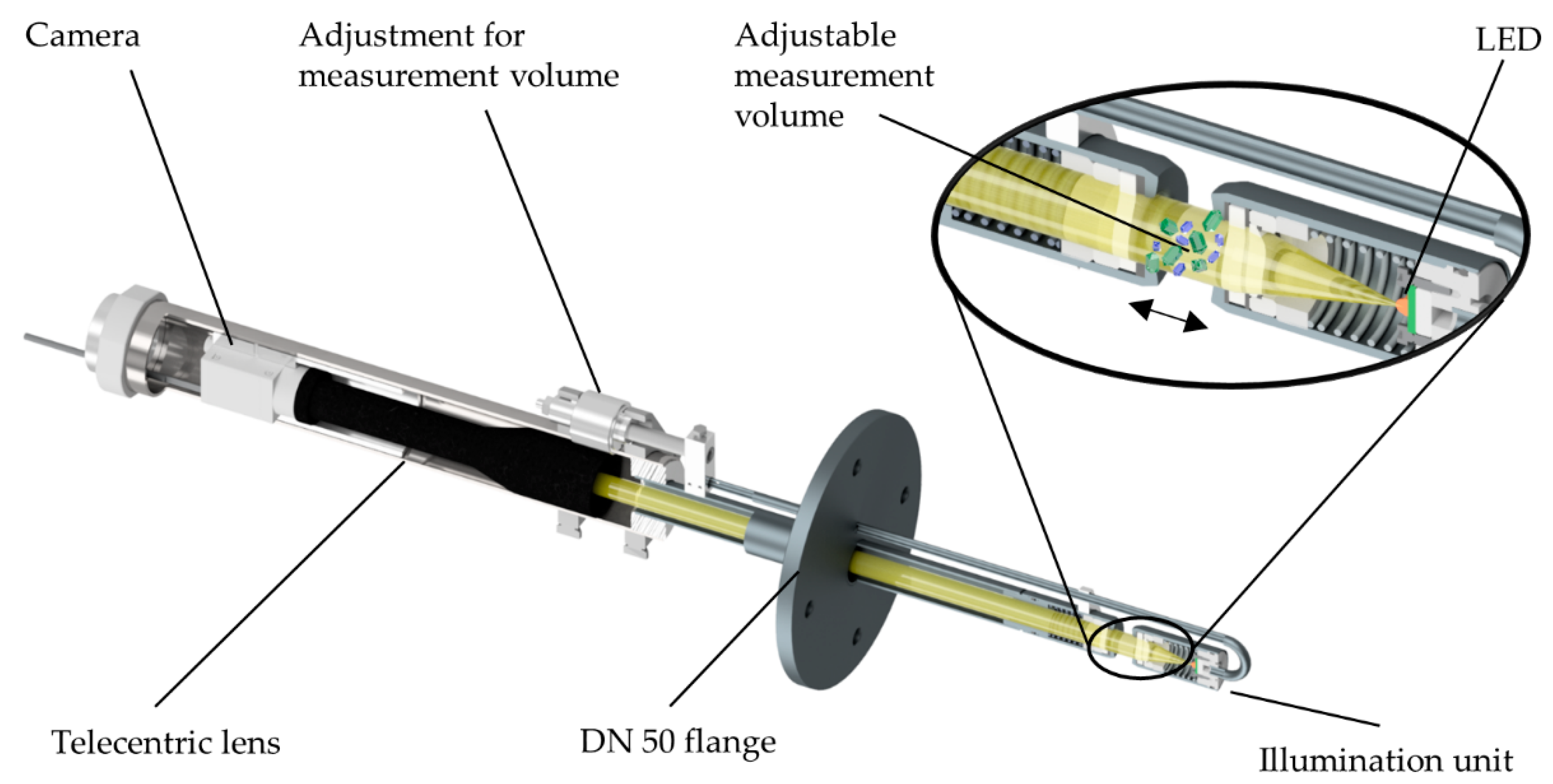
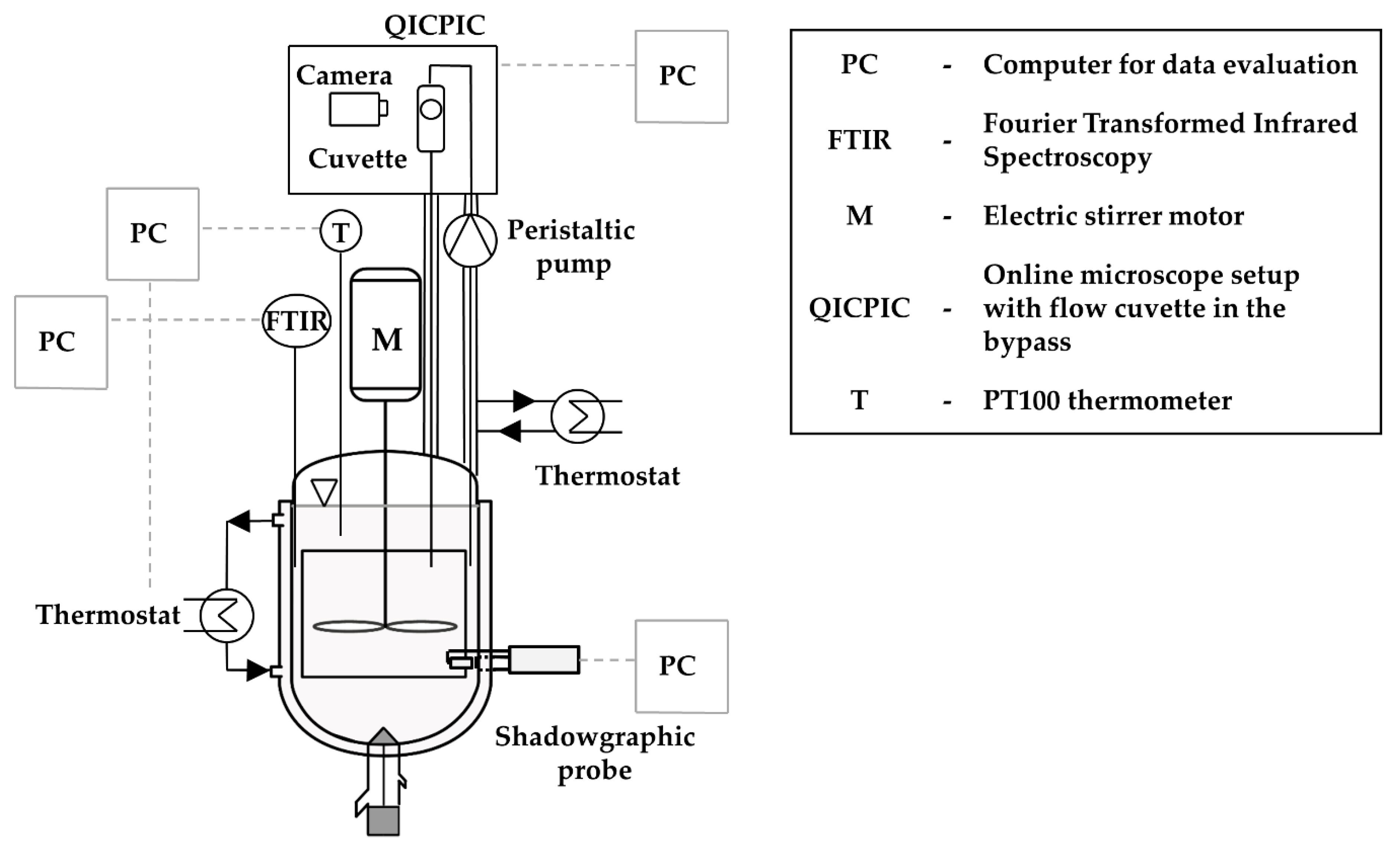
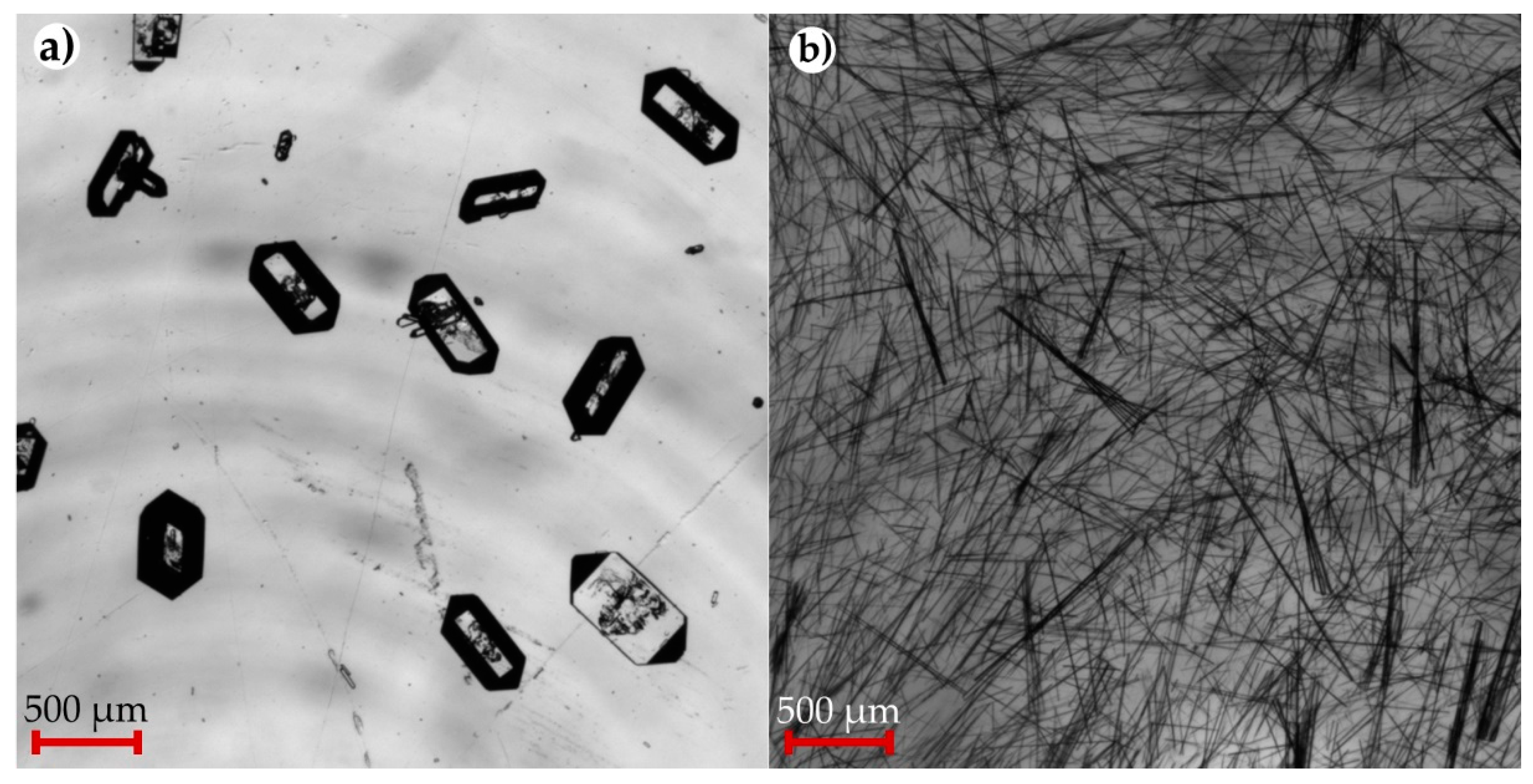
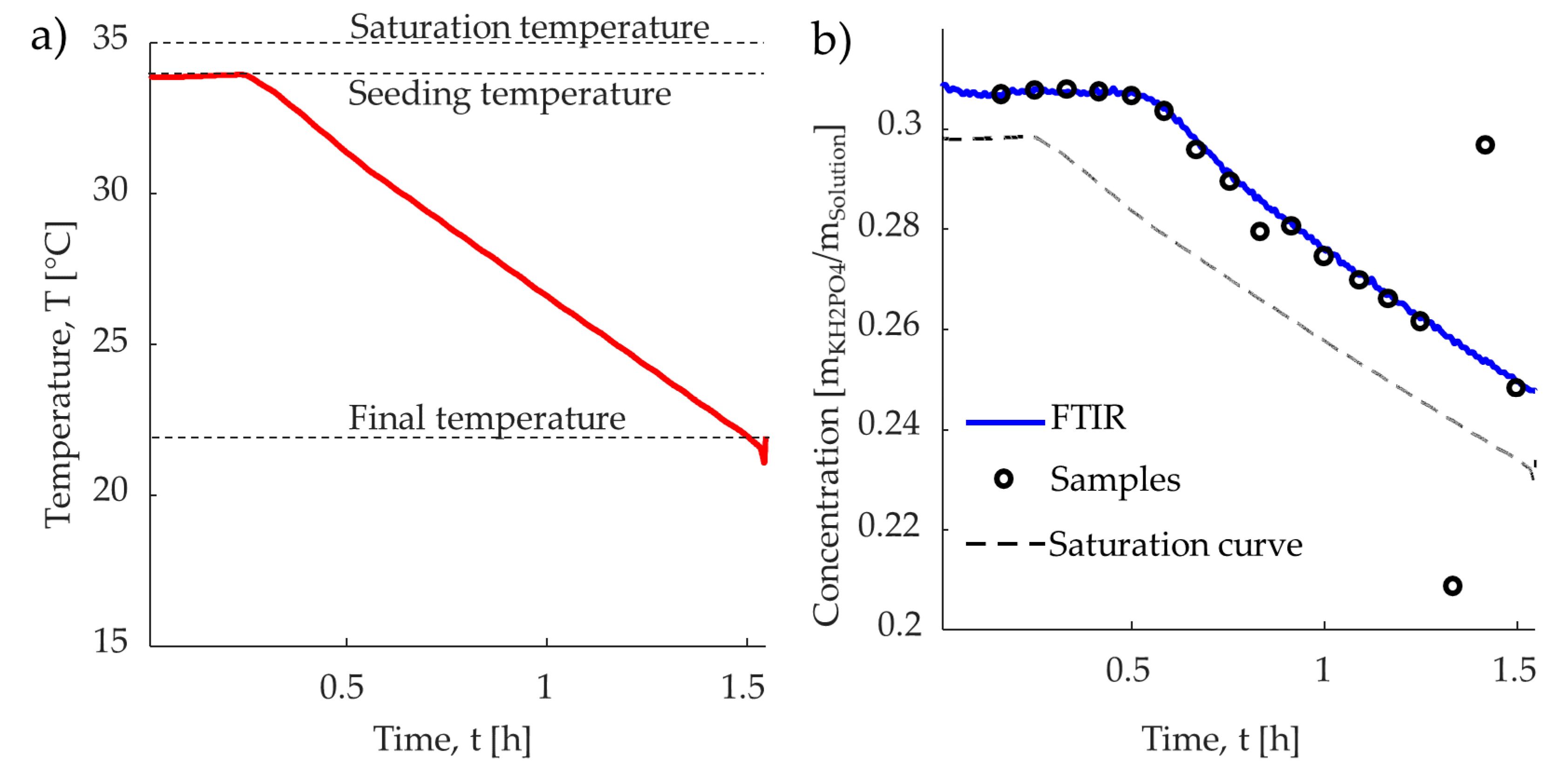
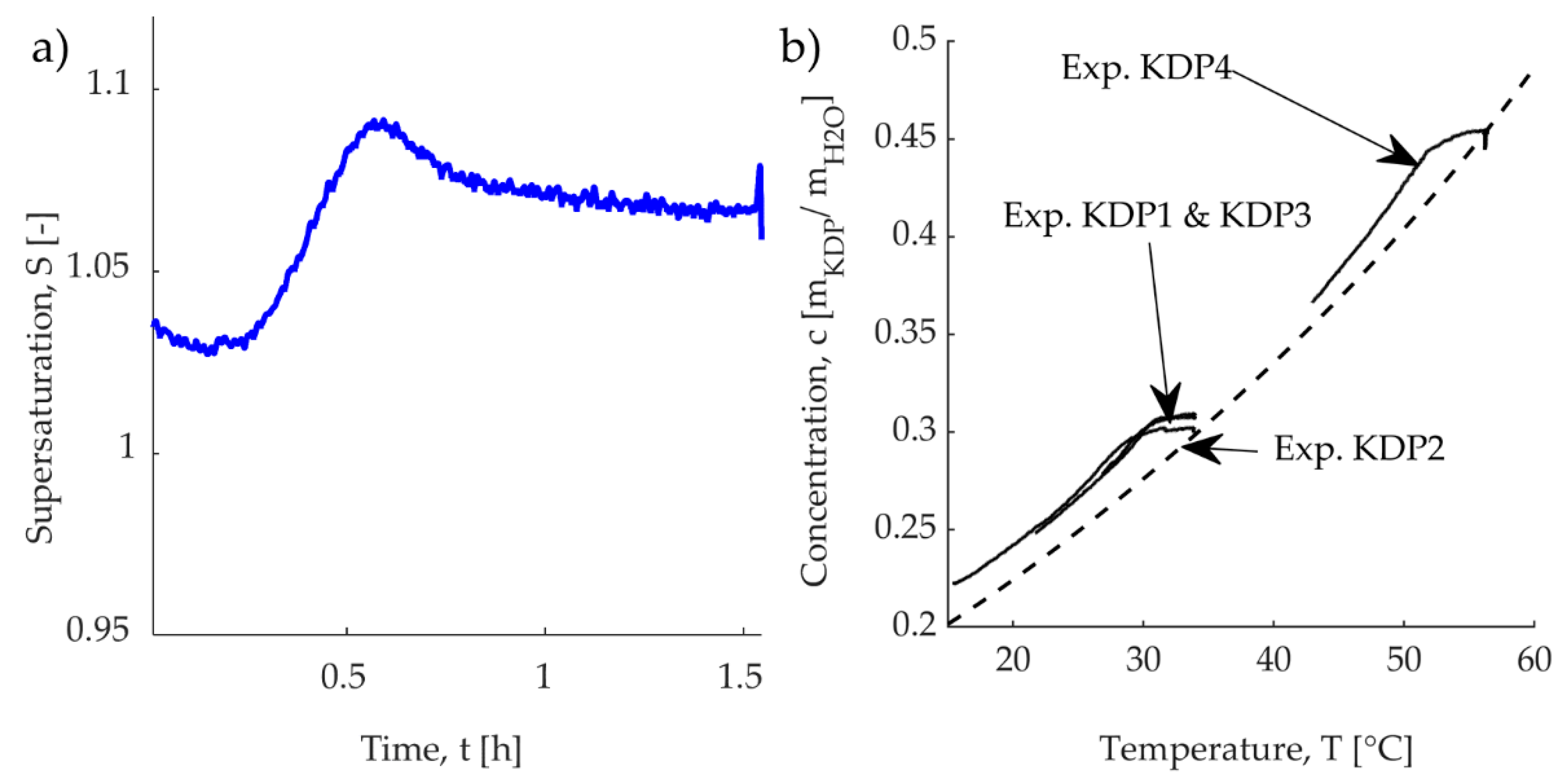
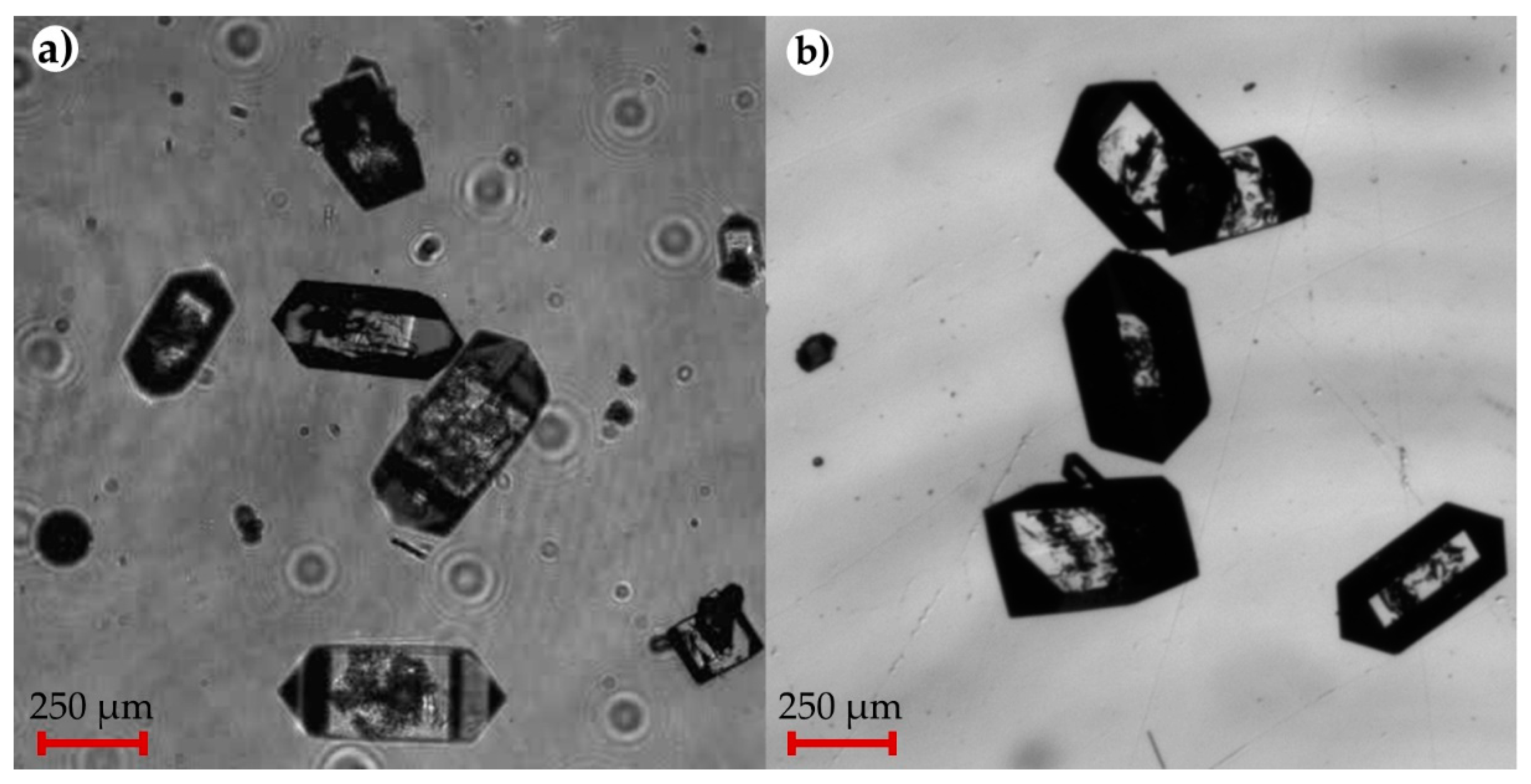
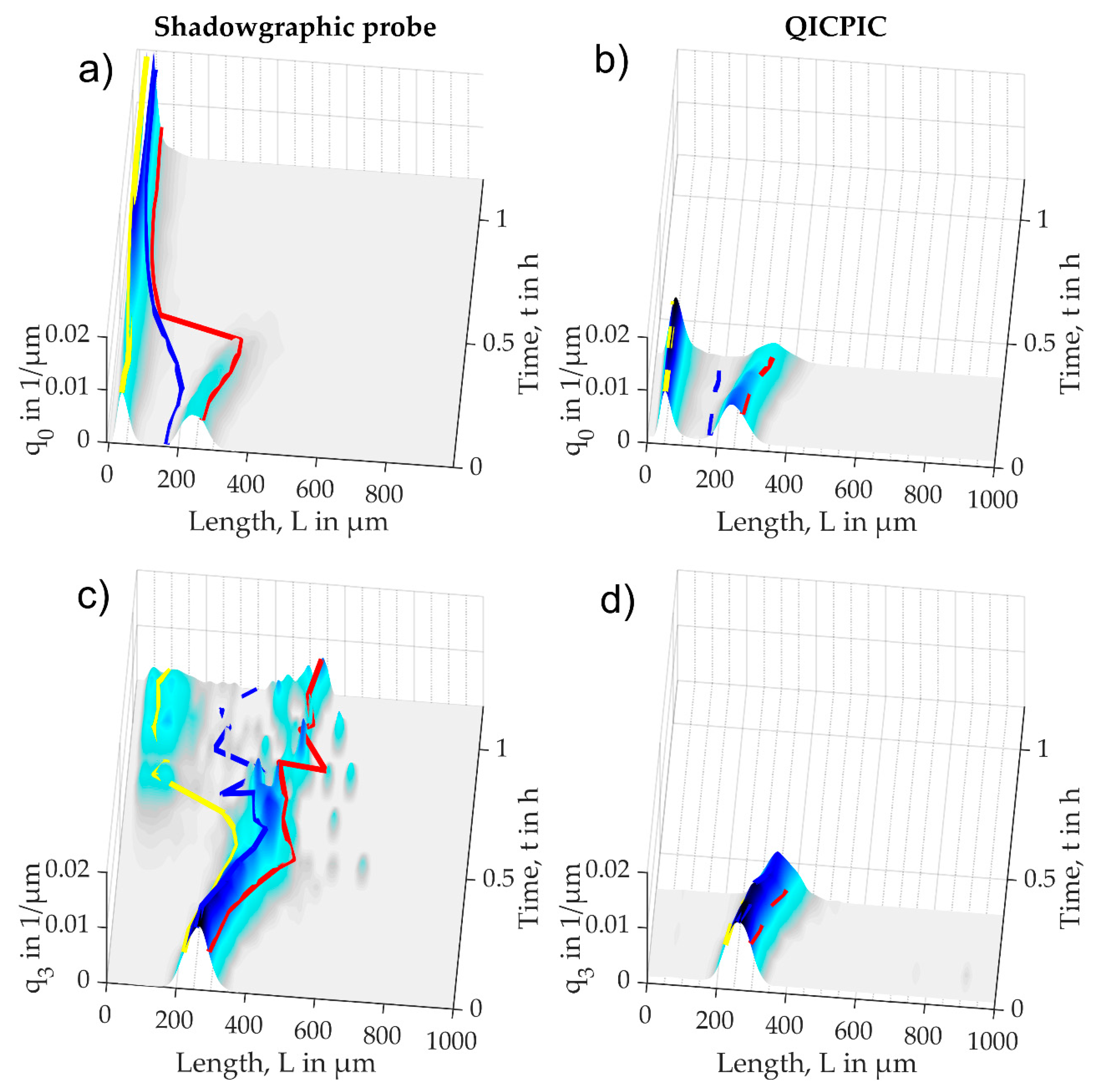
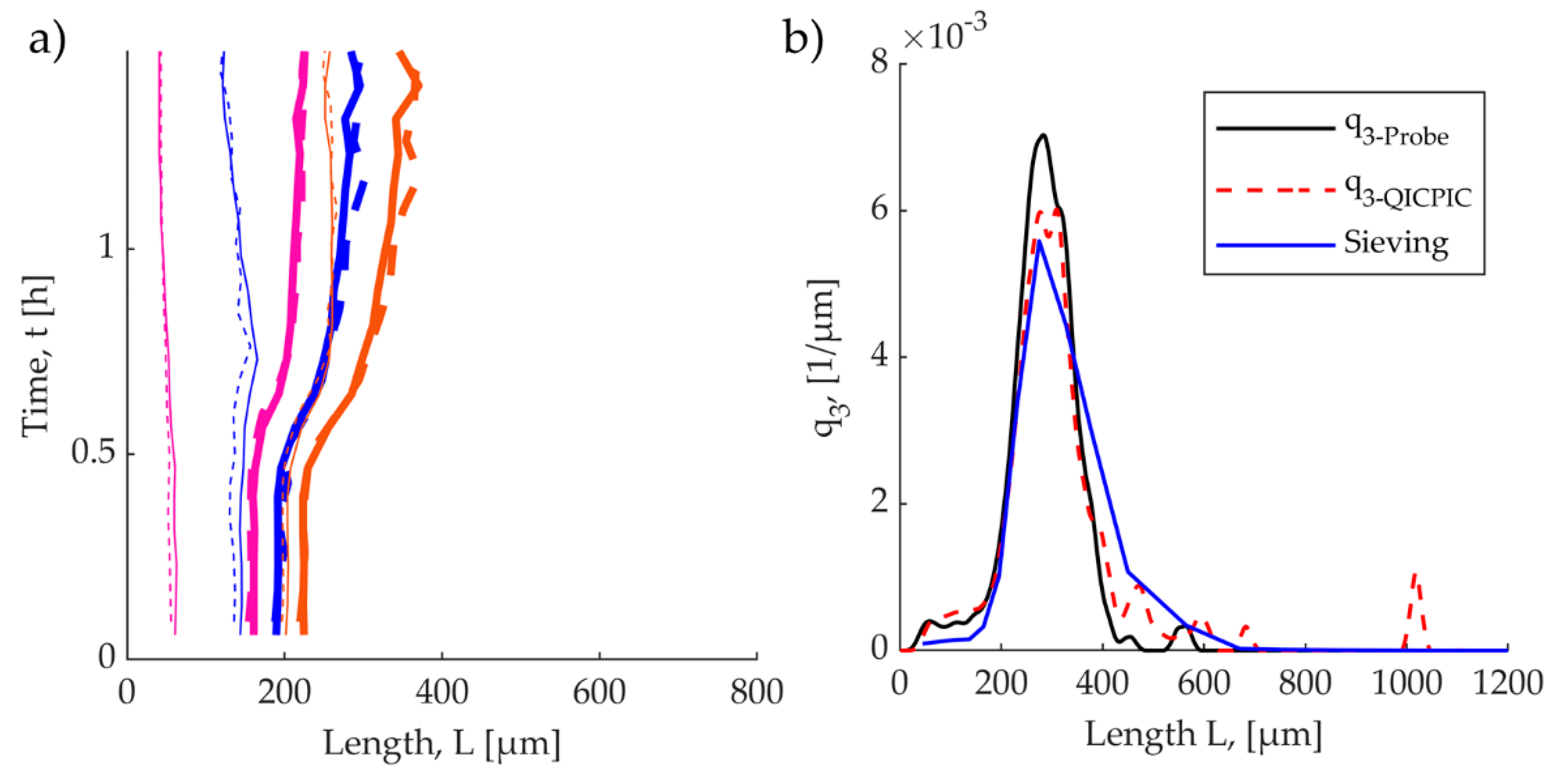
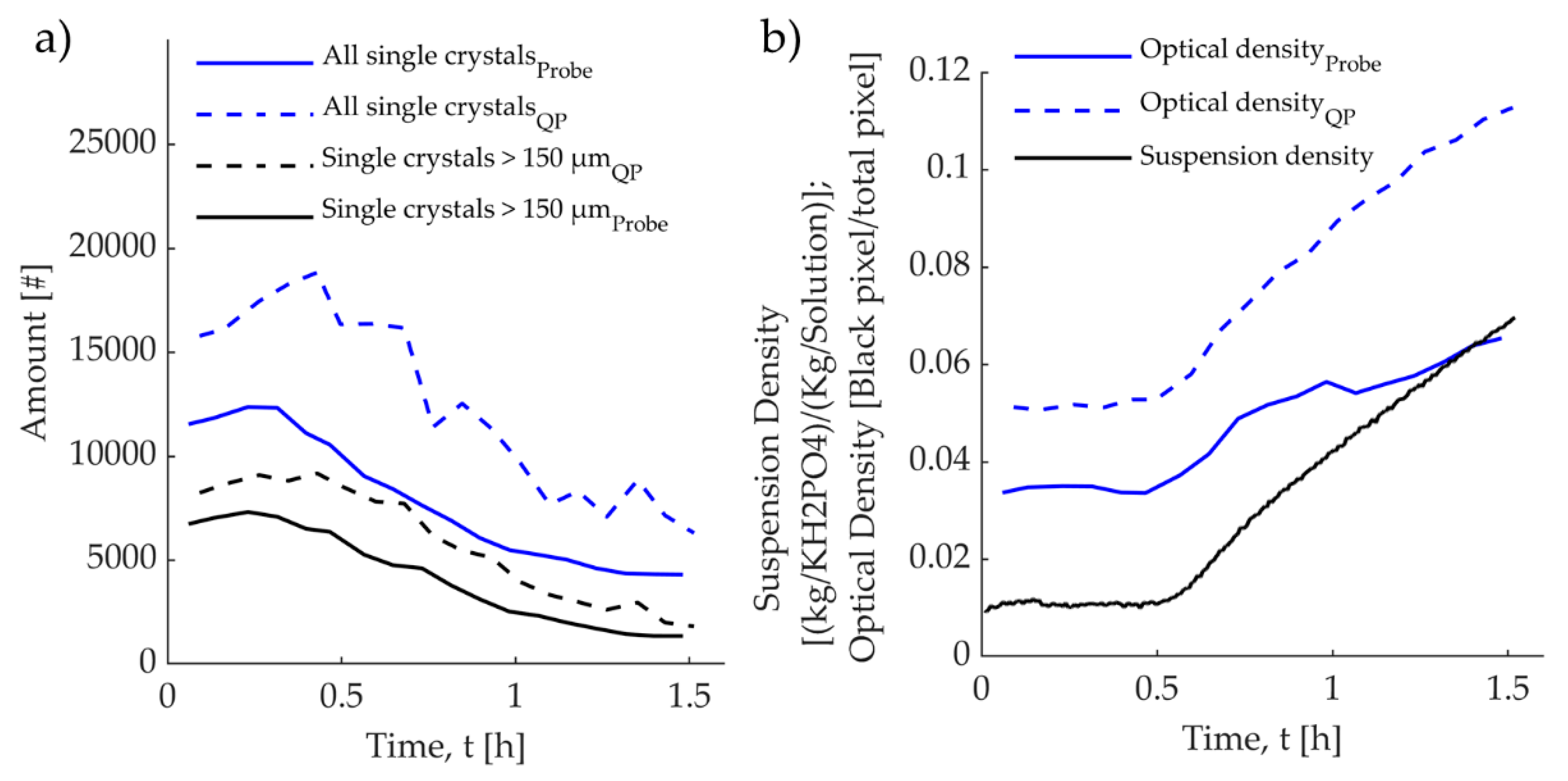
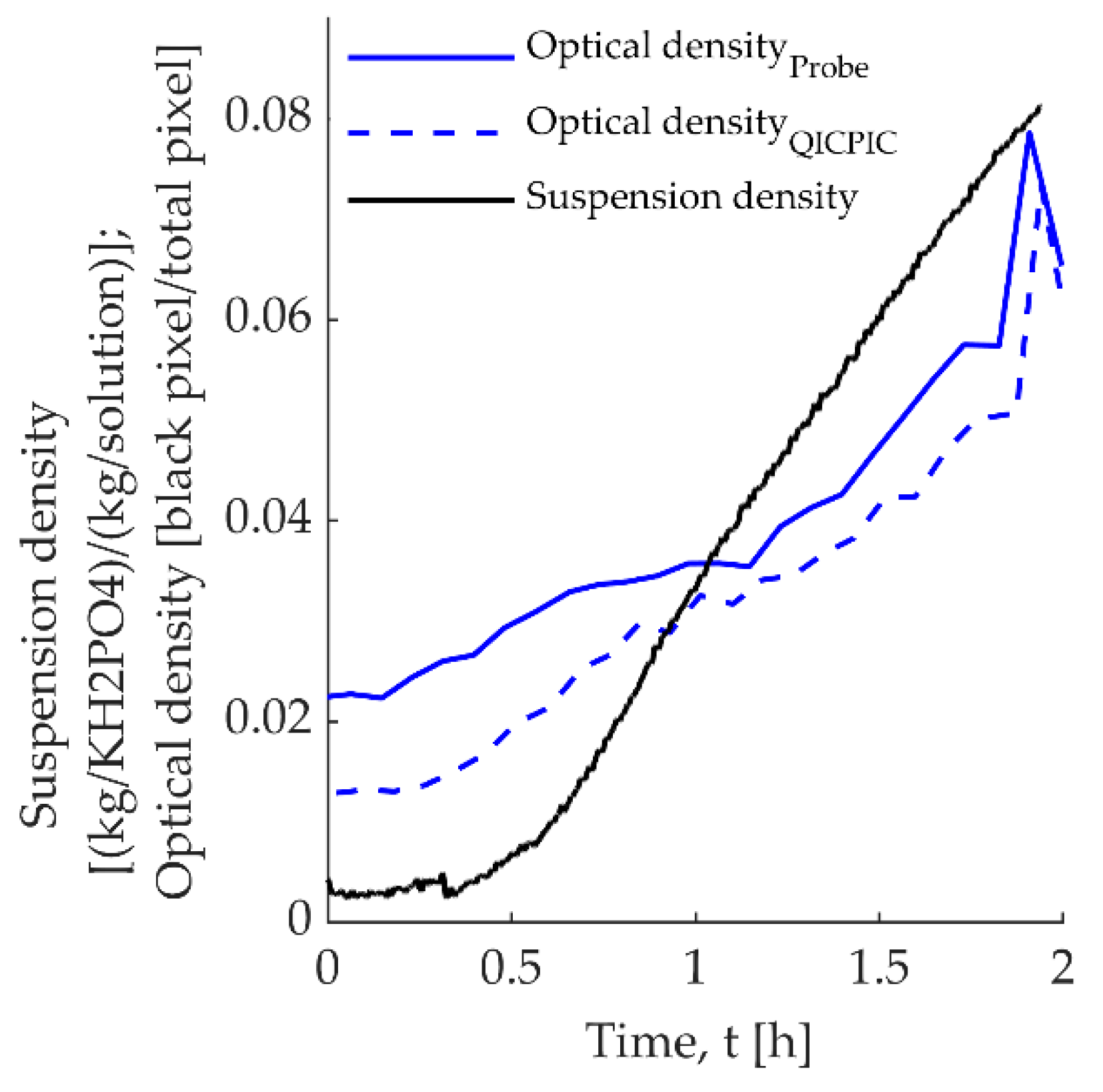
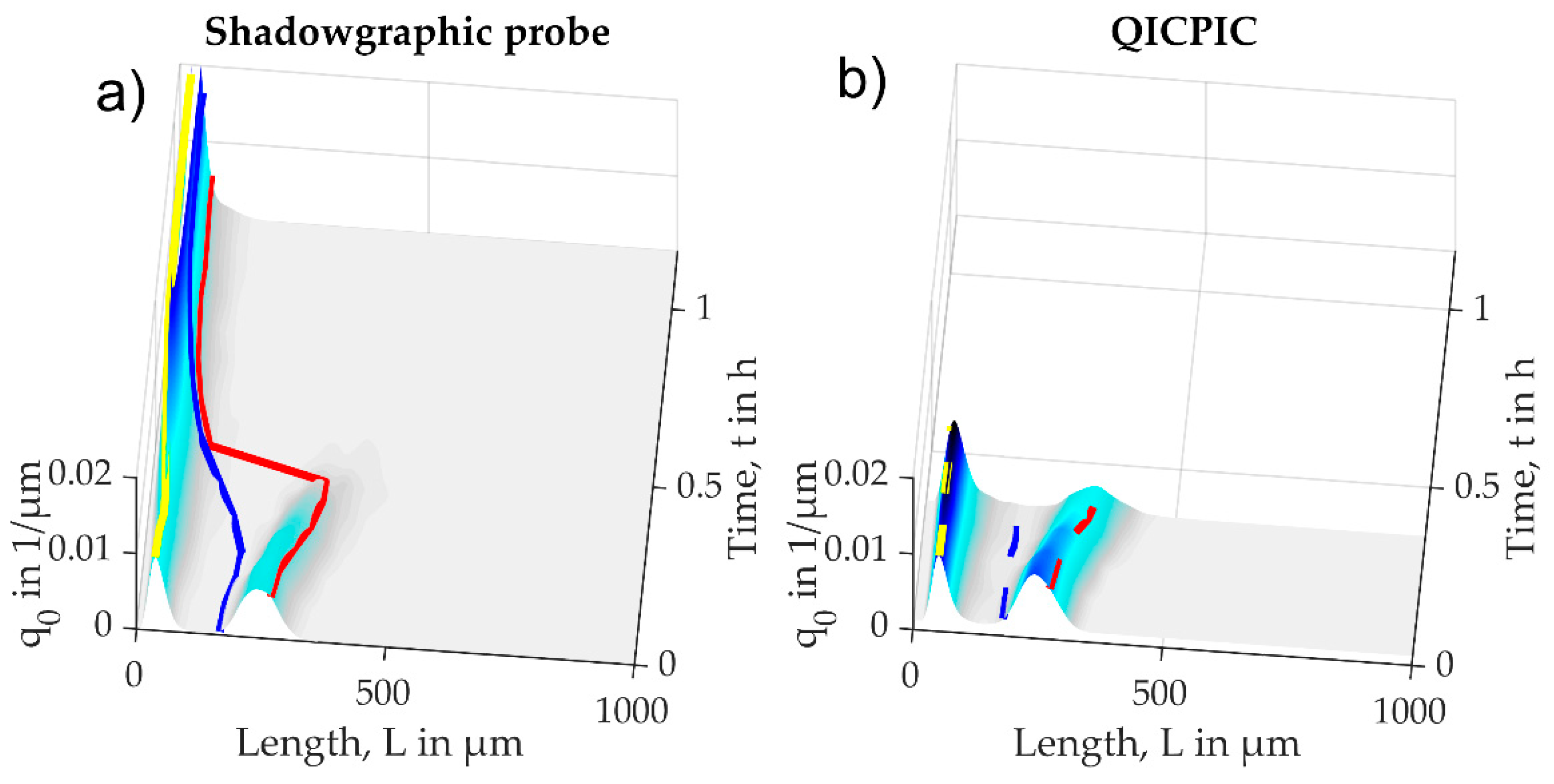
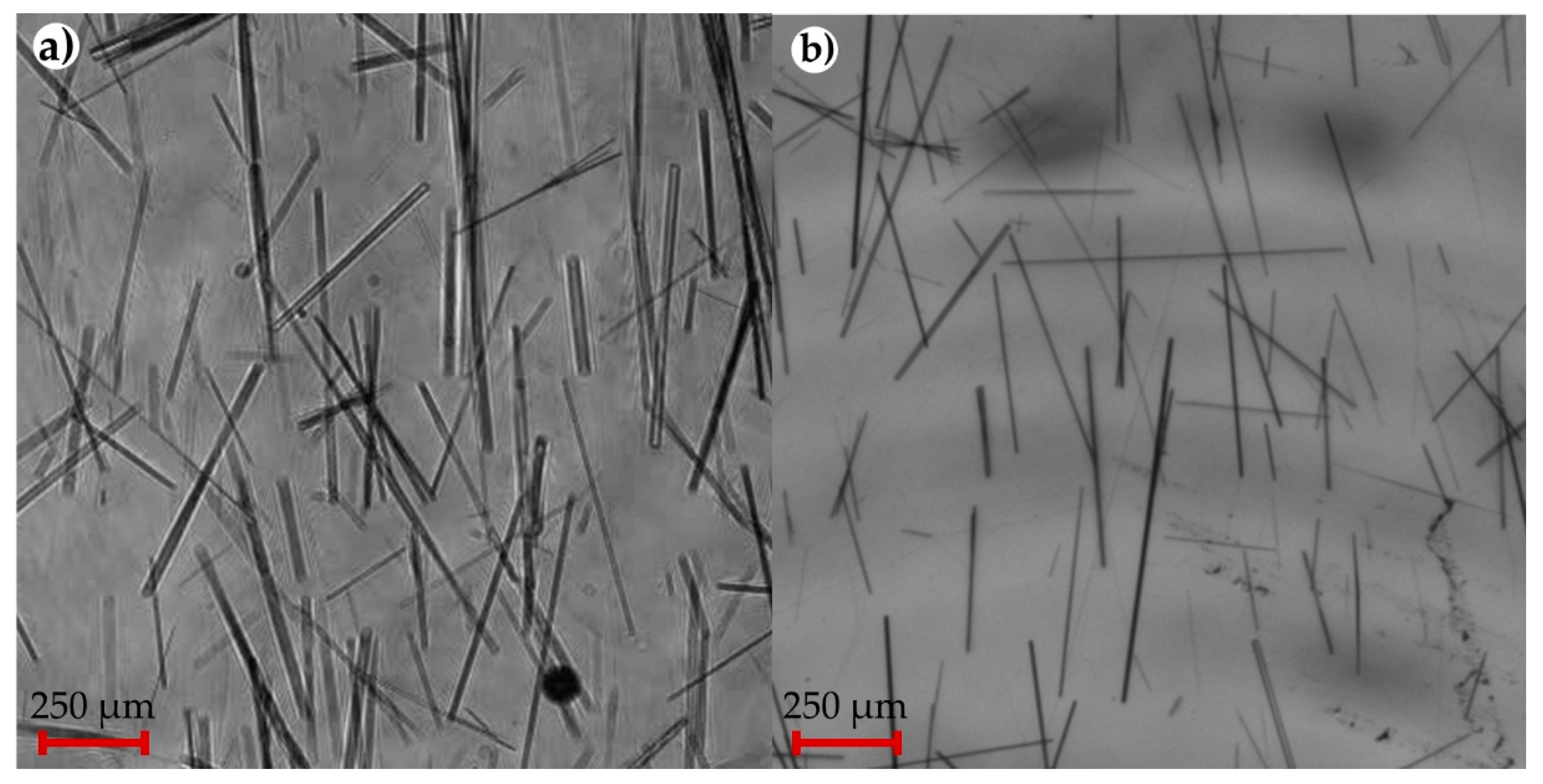
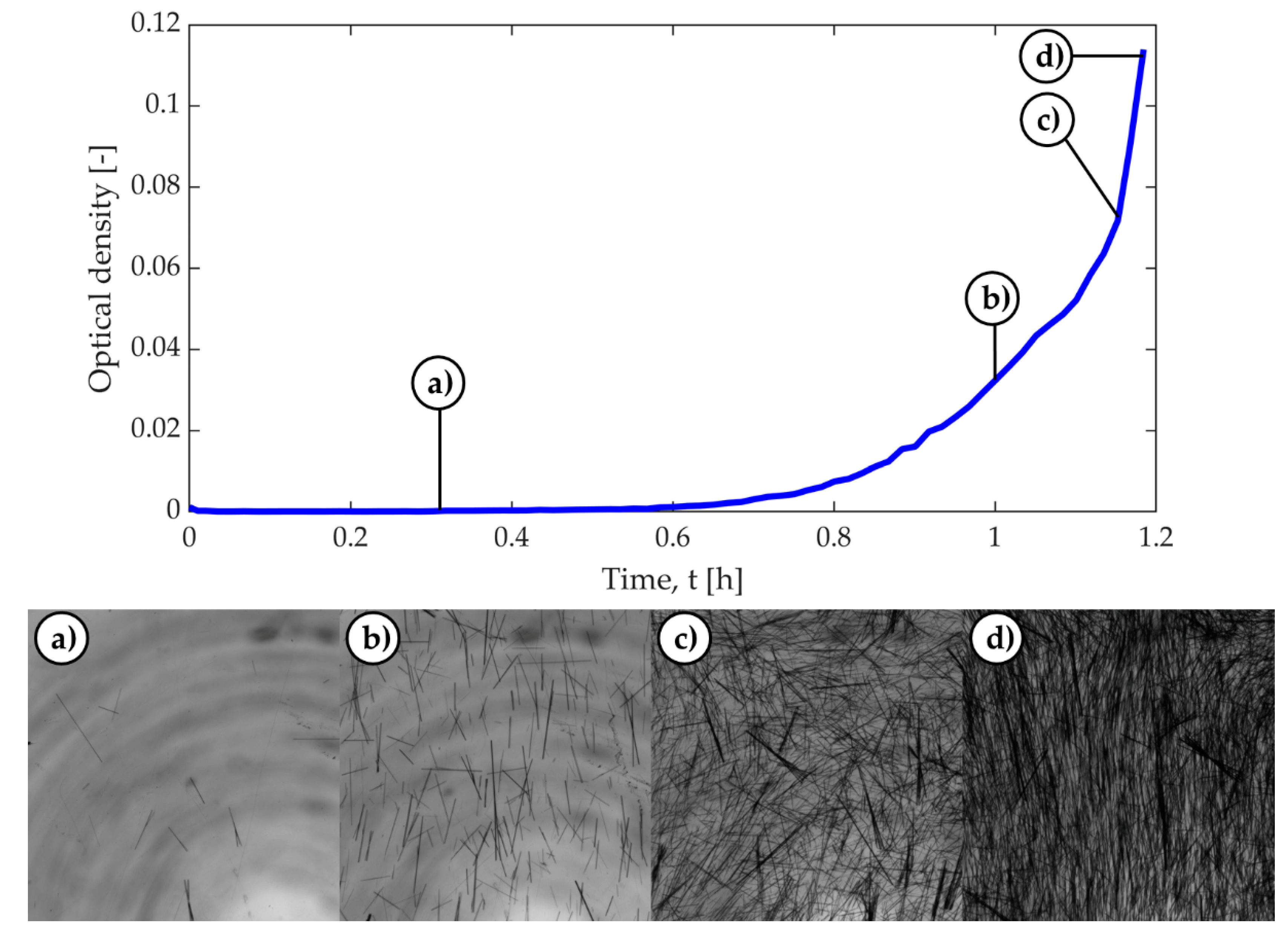
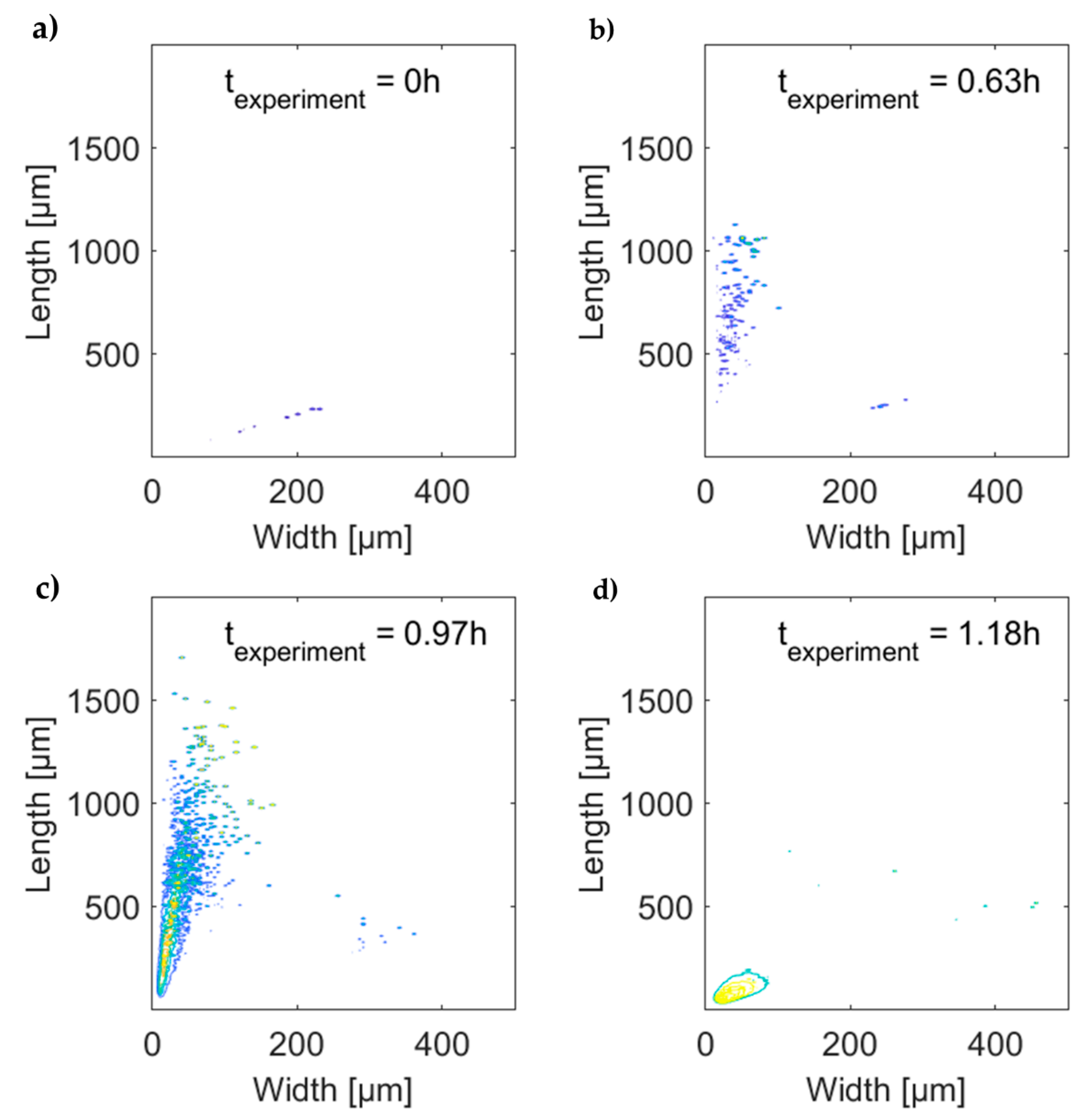
| Substance Properties | Symbol | KH2PO4 | Thiamine HCl Anhydrate | Unit |
|---|---|---|---|---|
| Solid density | 2340 | 1.4 | [kg/m3] | |
| Molar mass | 136.09 | 337.27 | [g/mol] | |
| Purity | ≥99 | ≥98 | [%] | |
| Vendor | Applichem | Sigma Aldrich |
| Exp. | ΔT/ Δt [°C/h] | TSat [°C] | TSeed [°C] | Tend [°C] | mH2O [°C] | mEtOH [kg] | msolute [kg] | mseeds [kg] |
|---|---|---|---|---|---|---|---|---|
| Exp. 1—KH2PO4 | −7.5 | 35 | 34 | 27 | 21 | - | 6.5 | 0.05 |
| Exp. 2—KH2PO4 | −10 | 35 | 34 | 15.5 | 21 | - | 6.5 | 0.1 |
| Exp. 3—KH2PO4 | −10 | 35 | 34 | 22 | 21 | - | 6.5 | 0.2 |
| Exp. 4—KH2PO4 | −12 | 56.5 | 56.4 | 43 | 21 | - | 9.5 | 0.1 |
| Exp. 5—thiamine hydrochl. | - | ≈30 | - | 25 | 5.6 | 12 | 4 | - |
| Mass-Averaged Crystal Width L [µm] at the Start | Mass-Averaged Crystal Width L [µm] at the End | ||||||
|---|---|---|---|---|---|---|---|
| Exp. no. | Seed Size [µm] | Experimental Time [h] | QICPIC | Probe | QICPIC | Probe | Sieving |
| Exp. 1 | 212–300 | 1.15 | 257 | 280 | 590 | 584 | 596 |
| Exp. 2 | 212–300 | 2.01 | 248 | 257 | 645 | 582 | 660 |
| Exp. 3 | 150–212 | 1.42 | 189 | 188 | 303 | 284 | 281 |
| Exp. 4 | 212–300 | 1.18 | 258 | 259 | - | 347 | 526 |
© 2020 by the authors. Licensee MDPI, Basel, Switzerland. This article is an open access article distributed under the terms and conditions of the Creative Commons Attribution (CC BY) license (http://creativecommons.org/licenses/by/4.0/).
Share and Cite
Wirz, D.; Hofmann, M.; Lorenz, H.; Bart, H.-J.; Seidel-Morgenstern, A.; Temmel, E. A Novel Shadowgraphic Inline Measurement Technique for Image-Based Crystal Size Distribution Analysis. Crystals 2020, 10, 740. https://doi.org/10.3390/cryst10090740
Wirz D, Hofmann M, Lorenz H, Bart H-J, Seidel-Morgenstern A, Temmel E. A Novel Shadowgraphic Inline Measurement Technique for Image-Based Crystal Size Distribution Analysis. Crystals. 2020; 10(9):740. https://doi.org/10.3390/cryst10090740
Chicago/Turabian StyleWirz, Dominic, Marc Hofmann, Heike Lorenz, Hans-Jörg Bart, Andreas Seidel-Morgenstern, and Erik Temmel. 2020. "A Novel Shadowgraphic Inline Measurement Technique for Image-Based Crystal Size Distribution Analysis" Crystals 10, no. 9: 740. https://doi.org/10.3390/cryst10090740
APA StyleWirz, D., Hofmann, M., Lorenz, H., Bart, H.-J., Seidel-Morgenstern, A., & Temmel, E. (2020). A Novel Shadowgraphic Inline Measurement Technique for Image-Based Crystal Size Distribution Analysis. Crystals, 10(9), 740. https://doi.org/10.3390/cryst10090740







